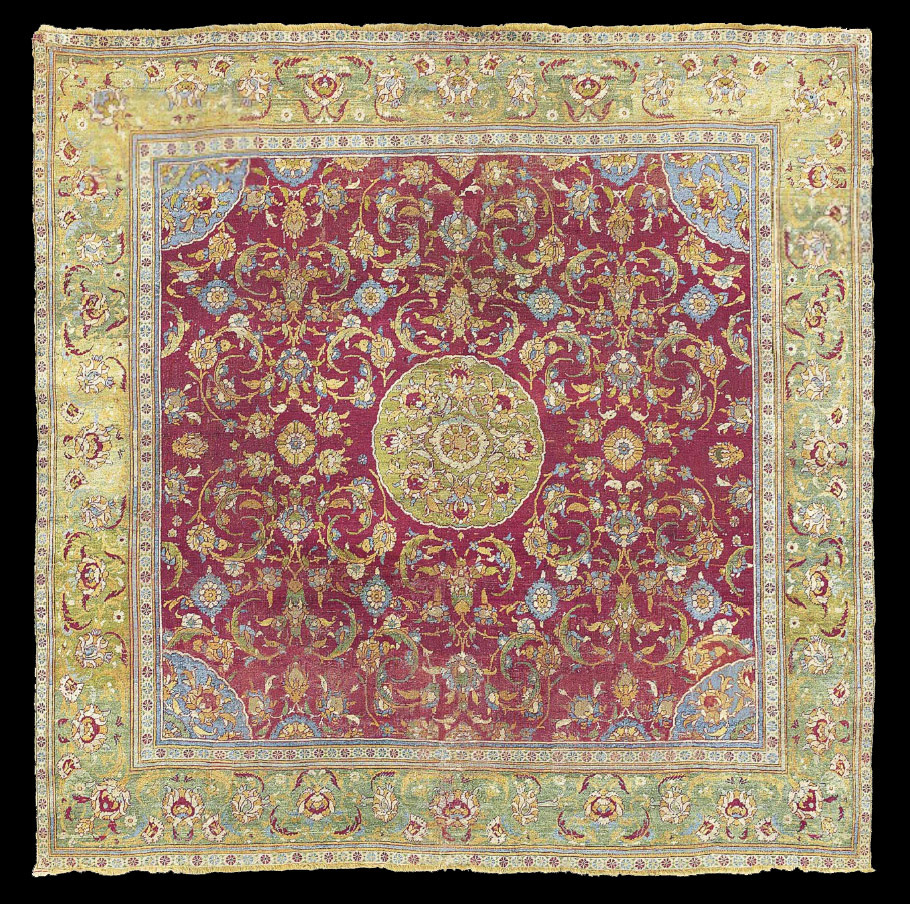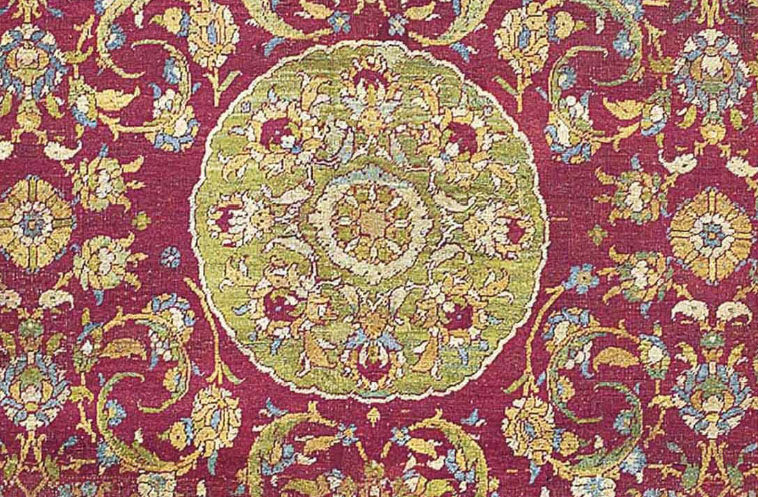|
The
Willy Von Dirksen Cairene Ottoman Carpet
EGYPT, PROBABLY CAIRO,
second half 16TH CENTURY
Price Realized £482,500 ($801,433)
Sale
Information
Christies SALE 1519 —
ORIENTAL RUGS & CARPETS
8 April
2014
London, King Street
Lot Description
THE DIRKSEN CAIRENE
CARPET
EGYPT, SECOND HALF 16TH CENTURY
Localised areas of wear with
associated faded repiling, a few small repairs, overall good condition
8ft.3in. x 8ft.2in (251cm. x 248cm.)
Provenance
With Willy von
Dirksen, by 1910
Saleroom Notice
Please note that this carpet is
published in Serare Yetkin, Historical Turkish Carpets, Istanbul, 1981,
p.115, illustration 72 as having been previously in the collection of L.
Bernheimer, Munich, p.115, illustration 72.
Literature
Meisterwerke Muhammedanischer Kunst, Katalog, Munich 1911, (reprinted
London, 1984), inv. 162 (R.39)
Friedrich Sphuler, Hans König, Martin
Volkmann, Alte Orientteppiche, Staatliche Museum fur Volkerkunde, Munich,
1978 no 2, pp.32-3
Kurt Erdmann; Oriental Carpets, London, 1955,
pp.47-51
Exhibited
Meisterwerke Muhammedanischer Kunst, Munich,
1910
Old Eastern Carpets, Masterpieces in German Private Collections,
Munich 1978
Lot Notes
The design of scrolling flowering vine
with rosettes, palmettes and curling saz leaves as seen here,
characterizes late sixteenth and early seventeenth century Ottoman carpets
produced in Cairo originally intended for the Sultan's court in Istanbul.
They were highly regarded and in turn were exported in considerable
numbers to the West. As these carpets were disseminated through Europe
they slowly began to appear in various Western paintings, in some more
clearly than others. One such painting A couple with a Dog, circa 1640 by
the Dutch artist, Elias Vonck (1605-1652), now in a private German
collection, clearly shows a square-shaped table with an Ottoman Cairene
carpet draped across its top, (Hali, April/May/June, 1987, Issue 34, p.6).
That carpet is very similar in design to the present lot, even down to the
individual single flower head minor stripes. The inclusion of these
carpets in paintings such as this, provide us with valuable information as
to when the carpets might have been woven which, in this case, must have
been at the turn of the century at the latest for it to have been woven,
shipped to Europe and painted within this time. For further examples of
paintings that include Cairene Ottoman paintings see Onno Ydema, Carpets
and their Datings in Netherlandish Paintings, 1540-1700, Zutphen, 1991,
pp.19-25.
The field design of the Dirksen Cairene is typical of one
sub-group where the medallion and spandrels are superimposed on an endless
repeating field of palmettes and saz leaves. A hand drawn diagram of the
design for this group is included in Erdmann op.cit, fig.t, p.49. Serare
Yetkin discusses this in her study on Turkish carpets (S. Yetkin,
Historical Turkish Carpets, Istanbul, 1981, pp.101-127; also Walter Denny,
'The Origin and Development of Ottoman Court Carpets', Oriental Carpet and
Textile Studies II, London, 1986, pp.243-259). A comparable example is in
the Städtische Kunstmuseum, Dusseldorf, (Kurt Erdman, The History of the
Early Turkish Carpet, London, 1977, fig.41, p.45), although the minor
stripes in that rug are a little more elaborate and the main roundel has
linked radiating petals issuing from its central flower head. The field
design on the Dirksen rug is also better spaced and allows the eye to
travel through the field and around each spiral without interruption.
Further examples, including some slight variants in the group, can be seen
in Otto Bernheimer; Alte Teppiche des 16.-18. Jahrhunderts der Firma L.
Bernheimer, Munich, 1959, pl.5., a rug in the collection of Prince Paar,
Vienna (Yetkin, op.cit., p.121, illus. 74) and a rug formerly in the
collection of Susan and Lewis Manilow, sold Sotheby's New York, 7 April
1992, lot 86.
It has been suggested that the earliest Cairene
carpets only used the three-colour Mamluk palette (see for example lot 99
in The Bernheimer Family Collection of Carpets, sold in these Rooms, 14th
February 1996), but by the mid-16th century a number of other colours had
been introduced, with a total of seven colours being employed in the
present lot; red, light blue, yellow, grass-green, pale green, tan and
white. The green and blue colours within this rug in particular, remain in
a wonderful state of preservation with a soft silky pile and glorious
luminosity. The popularity of these beautiful Ottoman carpets with Western
collectors has not ceased from the early part of the 17th century to the
present day, as demonstrated by their inclusion in most major carpet
collections of this period.


|


